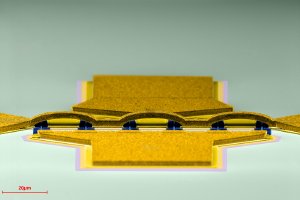Apr 18 2010
Transistors, the cornerstone of electronics, are lossy and therefore consume energy. Researchers from the ETH Zürich and EPF Lausanne have developed transistors targeting high switching speeds and higher output powers. The devices can be used more efficiently as conventional transistors, so as to reduce energy consumption and CO2 emissions.
 Perspective of an AlInN/GaN HEMT with 6 gate electrodes connected in parallel. (Photo: Andreas Alt)
Perspective of an AlInN/GaN HEMT with 6 gate electrodes connected in parallel. (Photo: Andreas Alt)
They consist of complex structures, some of which are only a few nanometers in size, and can be found in most electronic networks: transistors built from semiconductor materials deposited on a supporting substrate such as silicon carbide (SiC). Colombo Bolognesi, Professor for Millimeter-Wave Electronics at the ETH Zürich, and his research group specialize in developing high-performance transistors intended to transmit information as quickly and efficiently as possible. In order to do this, electrons must move through the semiconductor material as fast as possible. Just last year, Bolognesi`s group improved its own speed record for so-called «High Electron Mobility Transistors (HEMTs)» based on Aluminium-Gallium Nitride (AlGaN/GaN) materials depossited on Silicon substrates (see ETH Life article from 09.09.2009). Before then, comparable technologies showed cutoff frequencies of 28 Gigahertz (GHz), but devices built by Bolognesi`s Group in the FIRST cleanroom reached cutoff frequencies as high as 108 GHz.
New Material
Bolognesi's team, now in collaboration with the group of Nicolas Grandjean (who is a Professor of Physics at the EPF Lausanne) also explores a new material: instead of using Aluminium-Gallium Nitride, the researchers exploit the favorable properties of a newer material combination consisting of Alumimium Indium Nitride (AlInN/GaN). The advantage here is that AlInN has a significantly larger «forbidden energy gap» than other commonly used semiconductors. The so-called forbidden energy gap is one of the most important properties of a semiconductor material. Semiconductors featuring a large energy gap can be used to build transistors which operate at much higher temperatures, sustain greater voltage levels, and handle higher signal power levels than possible with smaller gap conventional materials such as Silicon. «Other researchers have already demonstrated that AlInN/GaN HEMT transistors can operate at temperatures as high as 1000 C – that far exceeds the capabilities of Silicon and even AlGaN/GaN transistors», says Bolognesi.
Until now, AlInN/GaN transistors were however slower than their AlGaN/GaN counterparts. The researchers have now eliminated this problem. They managed to break their own record of 102 GHz, achieved with AlInN/GaN transistors built on Silicon, with an AlInN/GaN transistor built on a Silicon Carbide substrate. In a single step, they increased the cutoff frequency by 41 percent up to 144 GHz. «That is a huge improvement», states Bolognesi with delight. «Imagine for example a sprinter who would suddenly run the hundred meter 40 percent faster». And fresh from the laboratory, as this article is being written, Bolognesi reports that his team just measured cutoff frequencies as high as 200 GHz. «That shatters all records in this research field».
Significant decrease in energy consumption
One possible commercial application of similar transistors could be in the power amplifiers driving wireless transmitter antennaes. There, Gallium Nitride transistors would help reduce energy costs thanks to their higher efficiency. For example, «a mobile phone operator with 10‘000 base stations equipped with conventional power amplifiers consumes on average 30 Megawatt each year, with associated CO2 emissions of 100‘000 tons», says Bolognesi. «Roughly 80 percent of that energy is just wasted as heat, and even more if the transmitter equipment must be air conditioned».
By using Gallium Nitride transistors, mobile telephone operators could significantly decrease their energy consumption, and reduce their CO2 emissions by several tens of thousand tons. Note that 10‘000 tons of CO2 corresponds to the CO2 emission from 5‘000 mid-class automobiles driven for 10‘000 kilometers per year. For reference, there is roughly 11‘000 wireless base stations currently operating throughout Switzerland.
Swissmade
Bolognesi believes Gallium Nitride based transistors could improve wireless transmitter efficiencies from 15 to 20 percent today, up to 60 percent. The researcher credits the group`s outstanding results to his team`s process know-how and dedication, the outstanding FIRST Laboratory facilities, as well as to the quality of the materials supplied by his EPFL collaborators. Encouraged by their recent achievements, the researchers continue to work with great enthusiam to further stretch the envelope of transistor performances.
The Canadian researcher is particularly satisfied that through this collaboration with his French colleague from the EPF Lausanne, the two Swiss Federal Institutes of Technology are able to claim a world-leading position for Switzerland in the strategically important field of wide energy gap transistor technology.